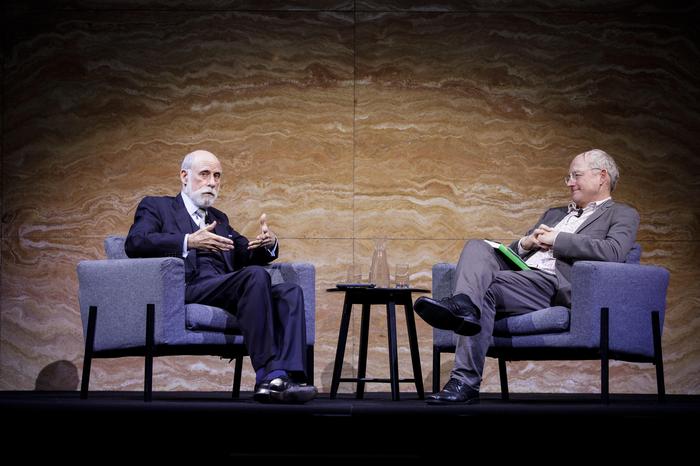Back in the ’70s, researchers in the US Department of Defence’s internetworking program needed to decide how much address space computers on “this Internet thing” were going to need.
Vint Cerf – considered one of the ‘fathers of the Internet’ along with TCP/IP protocol co-inventor Bob Kahn – on Thursday explained the workings behind why the address space of Internet Protocol version 4 (IPv4) ended up at 32-bits.
IP addresses are the unique sequence of numbers assigned to each publicly addressable computer, router, web server or Internet-connected device. IPv4 addresses are written as four numbers between 0 and 255 (four times eight bits), divided by dots. This type of address protocol is used to route the majority of the world’s Internet traffic.
First “we said how many networks are we going to need per country? Well two at least, so they’ll be some competition,” he told an audience at UNSW.
“And we said how many countries are there? And we didn’t know the answer to that, and there wasn’t any Google to find out! So we guessed at 128. So two times 128 is 256 which takes 8 bits to represent which network you’re on. Then we said how many computers per network?” he said.
At that time computers were “million dollar devices in air conditioned rooms”, Cerf – now Google’s chief Internet evangelist – explained. But the team still had the foresight to figure “they’ll get smaller and they’ll be more of them”.
Deciding on 16 million computers per network (the population of Australia at that time was only 12 million people) meant 24 bits were required for the host address.
“And so the next 24 bits of host address plus the 8 bits of network address is 32 bits, which is enough space. If you do 232 that’s close to 4.3 billion. Which was so close to the population of the earth that we thought surely that’s enough to do an experiment. And it was,” Cerf said.
Experiment is the key word. At that point researchers – although some had advocated for 128-bit space, which others considered “crazy” – thought an experiment was all they were doing.
“And I thought… that if this all worked that we then do a production version system, when we understand more deeply how much space we need,” Cerf said. “Well that didn’t quite work out the way we thought.”
To finite and beyond
IPv4, as Cerf describes it, “escaped the lab” and became widely used.
“And not in any small part from our pushing it out. We wanted the rest of the world to have access to the systems, not just the computer scientists and academics,” he said.
'This Internet thing' really took off.
“We realise there’s this massive proliferation of networks all over the world. So we thought OK, we’re going to run out of network address space,” Cerf said.
The free pool of available IPv4 was exhausted in 2011 according to Number Resource Organisation which coordinates the five Regional Internet Registries that manage the distribution of IP addresses.
Those Regional Internet Registries really, really ran out of new addresses earlier this year. Although people can buy and sell their IP addresses, the availability of unused public-facing IPv4 allocations is now practically depleted.
So Cerf and colleagues at the Internet Engineering Task Force – among them Australian internet pioneer Geoff Huston, now chief scientist at the Asia Pacific Network Information Centre – began working on IPv6.
(IPv5 was an ill-fated experimental video and voice streaming protocol which never launched)
IPv6 essentially makes the length of the IP address longer: a 128 bit address in eight 16 bit blocks.
The extra bits mean it supports up to 340 trillion, trillion, trillion (340 undecillion) addresses. It also simplifies address assignment (for computers) and provides additional security features.
But it hasn’t exactly been a runaway success.
“I thought everybody would instantly see the utility of having a larger address space – we’d have larger numbers of networks and larger numbers of devices and they’re getting get smaller and smaller,” Cerf says.
“The thing is nobody bothered to implement IPv6 because they said they hadn’t run out of IPv4 address space. It’s obvious we’re going to need it…we have been pushing,” he added.

There are a number of ways to gauge IPv6 adoption, but whatever way you look at it, it’s not high.
The percentage of the Alexa Top 1000 websites currently reachable over IPv6 is around 26 per cent. Google measures the availability of IPv6 connectivity among its users as of this month at 20 per cent. In Australia adoption rate is 13.1 per cent this month.
The slow progress has surprised IPv6’s developers.
“We had never suspected that the Internet would confront the exhaustion of one its most fundamental pillars, the basic function of uniquely addressing connected devices, and apparently shrug it off and continue on blithely. But, unexpectedly, that’s exactly what’s happened,” said Geoff Huston in a blog post earlier this month.
A workaround provided by Network Address Translation (NAT) is a headache to roll out and may not be sustainable.
The move to IPv6 is happening, albeit slowly. The protocol is not backwards compatible. Devices, routers and applications need to change to support it. Internet service providers and device makers seem happy to defer the inevitable.
On the other hand, Facebook reports it is in the process turning IPv4 off within its data centres; and Microsoft has stated similar intentions. “Increasingly, IPv4 is an unnecessary cost, and a speculative asset,” said the Internet Society in a recent State of IPv6 deployment report.
It’s been six years since World IPv6 Launch Day, but Cerf remains hopeful widespread adoption will come. If only he’d gone for 128 bits in the first place.
Cerf admits: “So that’s one calculation that Bob and I messed up!”

